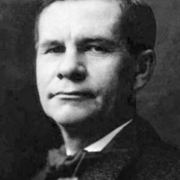Gustav, His Early Life

Gustav Stickley (who was Gustave until he dropped the “e” in 1903) was actually born Gustavus Stoeckel to Wisconsin German immigrant parents, the oldest boy of many children, in 1858. He worked alongside his father, a farmer and stone mason, quit school at 12 to help family finances, quickly learned he disliked his father’s heavy masonry work, (“…hard daily labor with a stubborn material…” he remembered), and moved with his family to Pennsylvania to be closer to his mother’s family after his father deserted them when Gustav was 17. His uncle owned a chair factory. Gustav proved to be gifted chair builder appreciating the “responsive, sympathetic qualities of wood” and later a good business manager too. Promoted to foreman, he had comfortable life, educated himself, got married, started a family but began to feel irresistibly strong personal ambitions that would guide the course of the rest of his life.
In 1883, Gustav and two brothers went into the chair business together, Stickley Brothers and Company, selling, both retail and wholesale, their own furniture and that of others. Later, as that relentless personal ambition took hold, he left his brothers and formed a new partnership with furniture salesman, Elgin Simonds, in 1888 to form Stickley and Simonds Company. However, Gustav would soon become unhappy with the elaborate and ornate designs they were still producing that remained popular. Those tastes of the Victorian period had lingered way beyond Gustav’s patience for something unique and new.
In England, 1888 was also the year that the Arts and Crafts movement was born. Gustav had made several trips to England and was attracted to its philosophies, design simplification, and emphasis on hand craftsmanship and honest work. Back home, differences arose. Stickley bought Simonds out in 1898, and Stickley’s personal ambition was unleashed!!!
Stickley’s “New Furniture” was introduced at a trade show in 1900 and distributed through Tobey Furniture Company of Chicago. Before long, frustrated that his name didn’t get the top billing he craved, he set out on his own in 1901 with his own furniture company, United Crafts, and published “The Craftsman” magazine for the first time.



